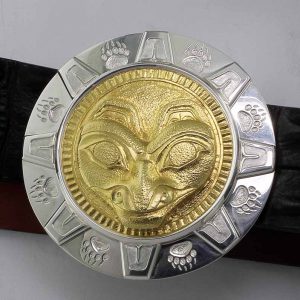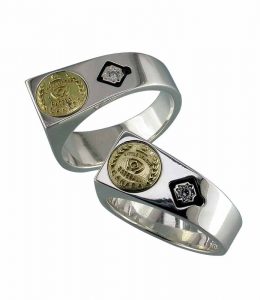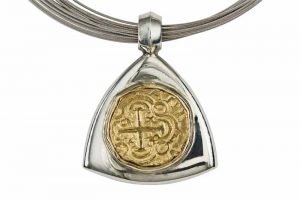
Deliberately oxidized surfaces are very popular, transforming this property of classic sterling silver into an advantage. Surface treatments are especially effective when applied to recessed areas of a design. This maximizes the contrast and will give visual depth to engraved or textured surface details. There are several methods of blackening silver, but most often, it is done via the application of liver of sulphur (basically potassium sulphide) to a prepared and cleaned surface.
Liver of sulphur typically comes in small chunks, which must be broken up and mixed with hot water. Take care to avoid breathing the powder while working with it—the rotten egg smell will discourage close contact! It should be stored in a dark environment, since it is light sensitive and will degrade over time. There are also other related chemicals available. It can be difficult to achieve a uniform colour with liver of sulphur, and several applications may be required, with cleaning and light abrasion between coats.

A matte surface tends to take the oxidation better than polished surfaces. My friend Alishan Halebian from California has a master’s touch with the application of blackened surfaces with smooth and consistent colour. He contrasts this surface with bold yellow gold gem-set ornamentation.
One can also electroplate silver with black rhodium to give an even deeper, richer colour, and while I do not personally like to use it, white rhodium is often electroplated over silver to prevent tarnishing. I find the rather chrome-like appearance is artificial-looking, and of course, over time it will abrade away and the piece will require replating. Some commercial silver jewellery is given a thin rhodium plating to prevent tarnish while sitting in the showcase. For greater durability, it could be plated with nickel first to seal the surface, then rhodium for the bright white colour.
An alternative to rhodium plating for standard copper-containing sterling silver involves heating the piece with a torch to bring the copper in the alloy to the surface. Putting it in the pickle will then remove the copper oxide. Repeat this process until the piece doesn’t turn black. This method is called depletion gilding, since it depletes the copper surface and leaves a thin layer of bright white pure silver that is very slow to tarnish.
Good as gold

As mentioned, silver looks very well when combined with gold. Rich 18- or 22-karat yellow gold provides maximum contrast, but one can use pink and green gold for different effects. When a client brought in a yellow gold reproduction of a bear motif plaque by Bill Reid, the master West Coast Canadian artist, I designed a surround in sterling silver engraved with complementary sun and bear claw motifs to create a substantial belt buckle.
For many years, Jewels by Design has provided service award rings for a Little League baseball organization. As the league is a nonprofit group, we were able to keep the price affordable by making the base ring from silver, with the addition of an 18-karat yellow gold insert with the club’s crest and a baseball ‘diamond’ inset and blackened with liver of sulphur.
Silver is also the traditional gift for 25th anniversary celebrations. A few years ago, a client requested two pendants to celebrate this milestone. He also wished to incorporate family birthstones. My solution was to make a sterling silver book and corresponding slipcase. The book, worn by the husband, opens to reveal the couple’s names engraved on the pages. The cover of each pendant is engraved with a Celtic tree of life motif, and the slipcase (for the wife) is set strategically with the birthstones (the parents at the ‘root’ and the children in the branches).
Silver linings
Silver has sometimes been relegated to being only a step above costume jewellery, and in fact there are rather a lot of insubstantial, poorly made silver items in the marketplace. In the hands of talented designers and craftspeople who understand the attributes (and limitations) of the metal, however, silver has a solid place in our industry. Offering both good value (i.e. attractive pricing) and inherent beauty, it well deserves its status as the ‘other’ white metal.
 Llyn L. Strelau is the owner of Jewels by Design in Calgary. Established in 1984, his by-appointment atelier specializes in custom jewellery design for local and international clientele. Strelau has received numerous design awards, including the American Gem Trade Association’s (AGTA’s) Spectrum Awards and De Beers’ Beyond Tradition—A Celebration of Canadian Craft. His work has also been published in Masters: Gemstones, Major Works by Leading Jewelers. Strelau can be reached via e-mail at designer@jewelsbydesign.com.
Llyn L. Strelau is the owner of Jewels by Design in Calgary. Established in 1984, his by-appointment atelier specializes in custom jewellery design for local and international clientele. Strelau has received numerous design awards, including the American Gem Trade Association’s (AGTA’s) Spectrum Awards and De Beers’ Beyond Tradition—A Celebration of Canadian Craft. His work has also been published in Masters: Gemstones, Major Works by Leading Jewelers. Strelau can be reached via e-mail at designer@jewelsbydesign.com.





